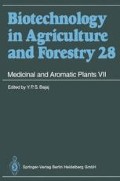Abstract
Baptisia tinctoria (L.) R. Brown (synonyms: Sophora tinctoria L., Polydaria tinctoria Michaux Willd., commonly known as rattle bush, horsefly weed, indigo weed, yellow indigo, or yellow clover broom) and other members of the genus Baptisia were traditional medicinal plants for the American natives (Hussey 1974; Millspaugh 1887). Leaves of B. tinctoria were also used as a plant-derived dye (Gr. bapto, Lat. tingere: dye). It is a member of the family of Fabaceae (Leguminosae) and forms bushy shrubs up to 1 m high with woody perennial rhizomes and roots and annual aboveground parts (Fig. 1). The round stems are usually erect, often widely branched, glabrous, occasionally slightly pubescent and yellowish green. The subsessile leaves are terminately compound, with subsessile cuneate, obovate leaflets of 1 to 1.5 cm length, and are bluish green in color.
Access this chapter
Tax calculation will be finalised at checkout
Purchases are for personal use only
Preview
Unable to display preview. Download preview PDF.
References
Adrosko RJ (1968) Natural dyes in the United States. Smithsonian Institution Press, Washington DC
Alston RE, Turner BL (1959) Application of paper chromatography to systematics: recombination of parental biochemical components in a Baptisia hybrid population. Nature 184:285–286
Alston RE, Turner BL (1963) Natural hybridization among four species of Baptisia (Leguminosae). Am J Bot 50:159–173
Alston RE, Turner BL (1969) Natural hybridization among four species of Baptisia (Leguminosae). Am J Bot 50:159–173
Alston RE, Rösler H, Naifeh K, Mabry TJ (1965) Hybrid compounds in natural interspecific hybrids. Proc Natl Acad Sci USA 54:1458–1465
Anonymous (1919) Fabaceae 33 rd Annu Report of the Bureau of American Ethnology to the Secretary of the Smithsonian Institution 1911–1912. Washington Government Printing Office, Washington
Berger F (1969) Handbuch der Drogenkunde V. Radices: Radix Baptisiae tinctoriae. Wilhelm Mandrich, Wien
Beuscher N, Kopanski L (1985) Stimulation der Immunantwort durch Inhaltsstoffe aus Baptisia tinctoria. Planta Med 5:357–472
Beuscher N, Kopanski L, Ernwein C (1988) Modulation of immune response by polymeric substances from Baptisia tinctoria and Echinacea angustifolia. Adv Biosci 68:329–336
Beuscher N, Scheit K-H, Bodinet C, Kopanski L (1989) Immunologisch aktive Glycoproteine aus Baptisia tinctoria. Planta Med 55:358–363
Beuscher N, Scheit KH, Bodinet C, Egerl D (1990) Modulation of host resistance by polymeric substances from Baptisia tinctoria and Echinacea purpurea. In: Masihi KN, Lange W (eds) Immunotherapeutic prospects of infectious diseases. Springer, Berlin Heidelberg New York, pp 59–63
Buchanan R (1987) A weaver’s garden. Interweaver Press, Loveland Co Claytonus DDJ (1762) Flora virginica. Lugdumi batavorum
Cranmer MF, Mabry TJ (1966) The lupine alkaloids of the genus Baptisia (Leguminosae). Phytochemistry 5:1133–1138
Farkas L, Szantho VV (1959) Untersuchung der Glycoside von Baptisia tinctoria L. I. Eine vereinfachte Synthese des Pseudobaptigenins. Acta Chim Acad Sci Hung vol 19:217–220
Farkas L, Varady J, Gottsegen A (1963) Untersuchung der Glykoside der Baptisia tinctoria R. Br., Synthese des 7.3′. 4′. 5′ Tetrahydroxy-isoflavons (Baptigenin). Chem Ber 96:1865–1867
Guder HJ (1981) Isolierung von Wirkstoffen aus Radix Baptisiae. Diplomarbeit, Universität Göttingen
Harnischfeger G, Stolze H (1983) Bewährte Pflanzendrogen in Wissenschaft und Medizin. Notamed, Bad Homburg
Hoppe HA (1975) Handbuch der Drogenkunde, de Gruyter, Berlin
Hussey JS (1974) Some useful plants of early New England. Econ Bot 28:311–330
Larisey MM (1940) A monograph of the genus Baptisia. Ann Mo Bot Gard 27:119–195
List PH, Hörhammer L (1972) Hagers Handbuch der pharmazeutischen Chemie, vol III. Springer, Berlin Heidelberg New York
Mabry TJ, Kagau J, Rösler H (1965) Baptisia flavonoids: nuclear magnetic resonance analysis. Phytochemistry 4:487–493
Madaus G (1938) Lehrbuch der biologischen Heilmittel. Thieme, Leipzig
Markham KR, Mabry TJ (1968) The structure and stereochemistry of two new dihydroflavonol glycosides. Tetrahedron 24:823–827
Markham KR, Mabry TJ, Swift WT (1970) Distribution of flavonoids in the genus Baptisia (Leguminosae). Phytochemistry 9:2359–2364
McHale J, Alston RE (1964) Utilization of chemical patterns in the analysis of hybridization between Baptisia leucantha and B. sphaerocarpa. Evolution 18:304–311
Meehan T (1885) Baptisia tinctoria. Meehans’ Monthly 5:81–82
Mevenkamp G, Lieberei R, Ogzewlla CD, Harnischfeger G (1991) In vitro propagation of Baptisia tinctoria. Planta Med 57 (Suppl) 2: A 31
Millspaugh CF (1887) American medicinal plants. Boericke and Tafel, New York
Murashige T, Skoog F (1962) A revised medium for rapid growth and bioassays with tobacco tissue cultures. Physiol Plant 15:473–497
Nowacki EK, Waller GR (1975) Comparative biosynthesis of quinolizidine alkaloids from DL-lysine in five species of Leguminosae. Phytochemistry 14:155–159
Ogzewalla CD (1987) Cultivation of Baptisia tinctoria. Report for Schaper and Brummer, Salzgitter
Oung-Boran P, Lebreton P, Netien G (1969) Contribution à l’étude biochimique et pharmacologique de Baptisia australis. Planta Med 17:301–318
Voß K (1992) Beeinflussung der Keimung von Baptisia tinctoria durch interne Faktoren des Samens. Diplomarbeit an der Naturwissenschaftlichen Fakultät, Universität Göttingen
Wagner H, Hörhammer W, Budweg W, Major A, Farkas L (1969) Synthese des Pseudobaptisins. Chem Ber 102:3006–3008
Wink M, Hartmann T, Witte L, Schiebel HM (1981) The alkaloid pattern of cell suspension cultures and differentiated plants of Baptisia australis and their biogenetic implications. J Nat Prod. 44(1): 14–20
Wink M, Witte L, Hartmann T, Theuring C, Volz V (1983) Accumulation of quinolizidine alkaloids in plants and cell suspension cultures: genera Lupinus, Cytisus, Baptisia, Genista, Laburnum and Sophora. Planta Med 48:253–257
Author information
Authors and Affiliations
Editor information
Editors and Affiliations
Rights and permissions
Copyright information
© 1994 Springer-Verlag Berlin Heidelberg
About this chapter
Cite this chapter
Mevenkamp, G., Lieberei, R., Harnischfeger, G. (1994). Baptisia tinctoria (L.) R. Brown: Micropropagation, In Vitro Culture and Production in Direction of Pharmaceutically Used Root Biomass. In: Bajaj, Y.P.S. (eds) Medicinal and Aromatic Plants VII. Biotechnology in Agriculture and Forestry, vol 28. Springer, Berlin, Heidelberg. https://doi.org/10.1007/978-3-662-30369-6_3
Download citation
DOI: https://doi.org/10.1007/978-3-662-30369-6_3
Publisher Name: Springer, Berlin, Heidelberg
Print ISBN: 978-3-662-30371-9
Online ISBN: 978-3-662-30369-6
eBook Packages: Springer Book Archive

